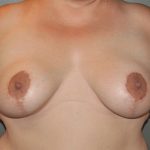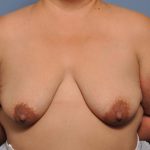
Sagging of one’s breasts, known as ptosis, is a natural phenomenon that occurs from pregnancy, aging, and the weight of heavy breasts over time. It is the result of skin stretch and the weakening of the support ligaments between the skin and the chest wall, both of which causes the breast mound to fall over the fixed lower breast crease. Invariably, the nipple on the mound ends up pointing downward to some degree.
Breast ptosis has a formal classification system which is relevant because it impacts what type of breast lift is needed. The degree of ptosis is determined by where the nipple sits relative to the lower breast crease. Normal is above the breast crease, ptosis severity as graded I through IV is how far the nipple is below the crease.
A breast lift, also known as a mastopexy, comes in four fundamental types. Nipple (type I) and periareolar (type II) mastopexies keep the scars around the nipple but only produce a cm. or two of breast lifting. They work best when combined with an implant. Vertical (type III) and combined vertical and horizontal (type IV) mastopexies result in scars that leave the nipple and extend downward. They produce the greatest degree of breast lift and tightening and are aften done without an implant.
A breast lift has the potential to lift the nipple back up above the lower breast crease while improving breast shape. Matching the degree of ptosis with the type of breast lift is key to a successful result.
2. What is the difference between a breast lift and a breast reduction?
From a skin and scar standpoint, a full (type IV) breast lift and reduction seems the same. The scars are identical, going around the nipple with a vertical extension down to the lower breast where it joins a horizontal scar. This breast scar pattern is known as the inverted T or anchor.
It is what is done, or not done, on the inside of the breast that is the difference. A breast lift removes no breast tissue, just lifts the nipple and tightens the skin around the breast mound. In contrast, a breast reduction not only does that but also reduces the size of the breast mound, making it smaller and weigh less. In short, a breast lift is not a breast reduction but a breast reduction always includes a breast lift.
3. Can an implant be done at the same time as a breast lift?
Lifting a sagging breast alone is often not enough. Unless one has a significant amount of breast tissue, a breast lift will not make most breasts look bigger. In some cases, they will look smaller after being lifted. As a result, many breast lifts receive an implant at the same time.
This combination lift and implant breast reshaping is an artistically difficult operation to do. How much can you lift and tighten the skin vs the size of the implant makes for some key intraoperative judgments. And one must also be careful not to interrupt the blood supply to the nipple in performing each maneuver. As a result, the revision rate on this breast operation is not low and two stages are often needed to get the best result.
4. Are the results from a breast lift permanent?
The initial results from most breast lifts must be overdone or overcorrected. The breast mound is lifted higher and fuller (on the upper part of the breast) to account for some settling which will invariably occur in the first month or two after surgery. Once the breast mound has settled ( 3 to 6 months), the result will be relatively
Stable.
There are many factors, however, that determine the long-term stability of a breast lift. Your age, will you get pregnant again, will you gain or less significant weight in the years ahead, and did you get an implant with your breast lift. The nipple position will stay the same but it is the shape of the breast mound and the tightness of the skin around it that can be affected by these other factors.
5. What is a laser bra lift?
Some amount of recurrent sagging or bottoming out of a breast is well known to occur after breast lift and breast reduction surgery. The support of the lower portion of the breast only comes from the skin which is often thin and prone to stretch and relaxation
As part of a breast lift, the mound is tightened by the removal of skin and bringing the edges together. In trying to improve the postoperative problem of bottoming out, the laser bra lift uses the concept of skin preservation. Rather than cutting out and throwing away the excess skin, the laser removes the outer layer of skin (epithelium) that normally would have been thrown away and keeps the underlying collagen layer. (dermis)The reshaped breast skin is then closed over it during the lift. This preserved skin layer then acts like an ‘internal bra’, adding an extra layer of support to resist any sagging afterwards. The laser bra lift is simply a clever and effective use of your own tissue to improve a well known breast lift problem.
6. What is the recovery after a breast lift?
Because breast lifts work only on skin and breast tissue, there actually is very little discomfort after surgery. Short of limited strenuous activity in the first two to three weeks, there are no other physical restrictions. One can return to work within days of the procedure.
When an implant is placed at the same time as a lift, there will be discomfort and recovery. Short of a lot of lifting, one can still return to work within seven to ten days after.
One also needs to factor in the ‘visual side’ of recovery, how long until the breast scars fade. This could take six months or longer until the breast scars have matured and reached their best appearance.
7. Can a breast lift be redone later?
Because of the residual scars that are left from a breast lift, there is always the opportunity to use them to further lift and tighten a breast. If one undergoes pregnancy or weight loss, the breasts may need a secondary tuck-up or tightening.
Dr. Barry Eppley
Indianapolis, Indiana



